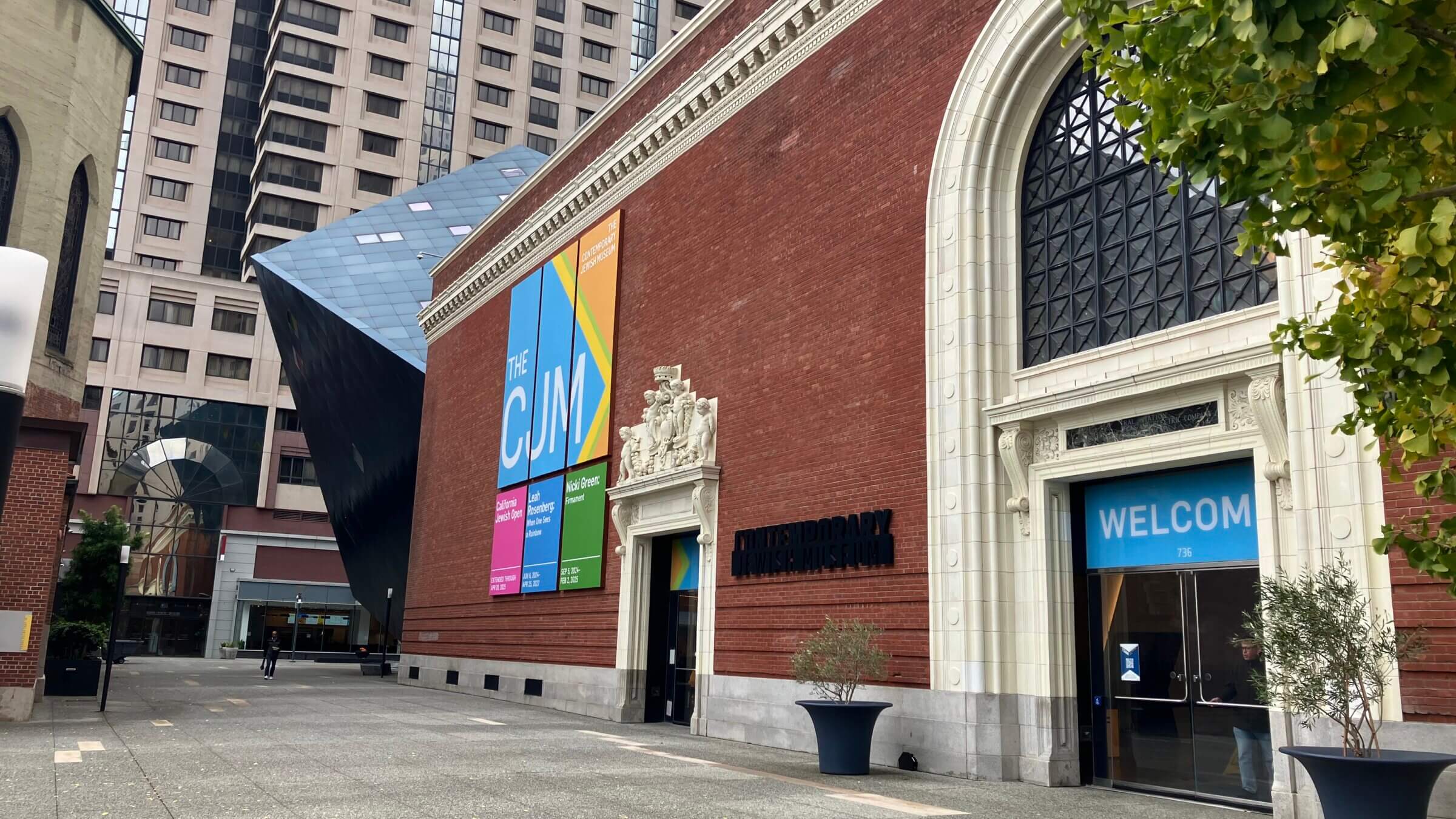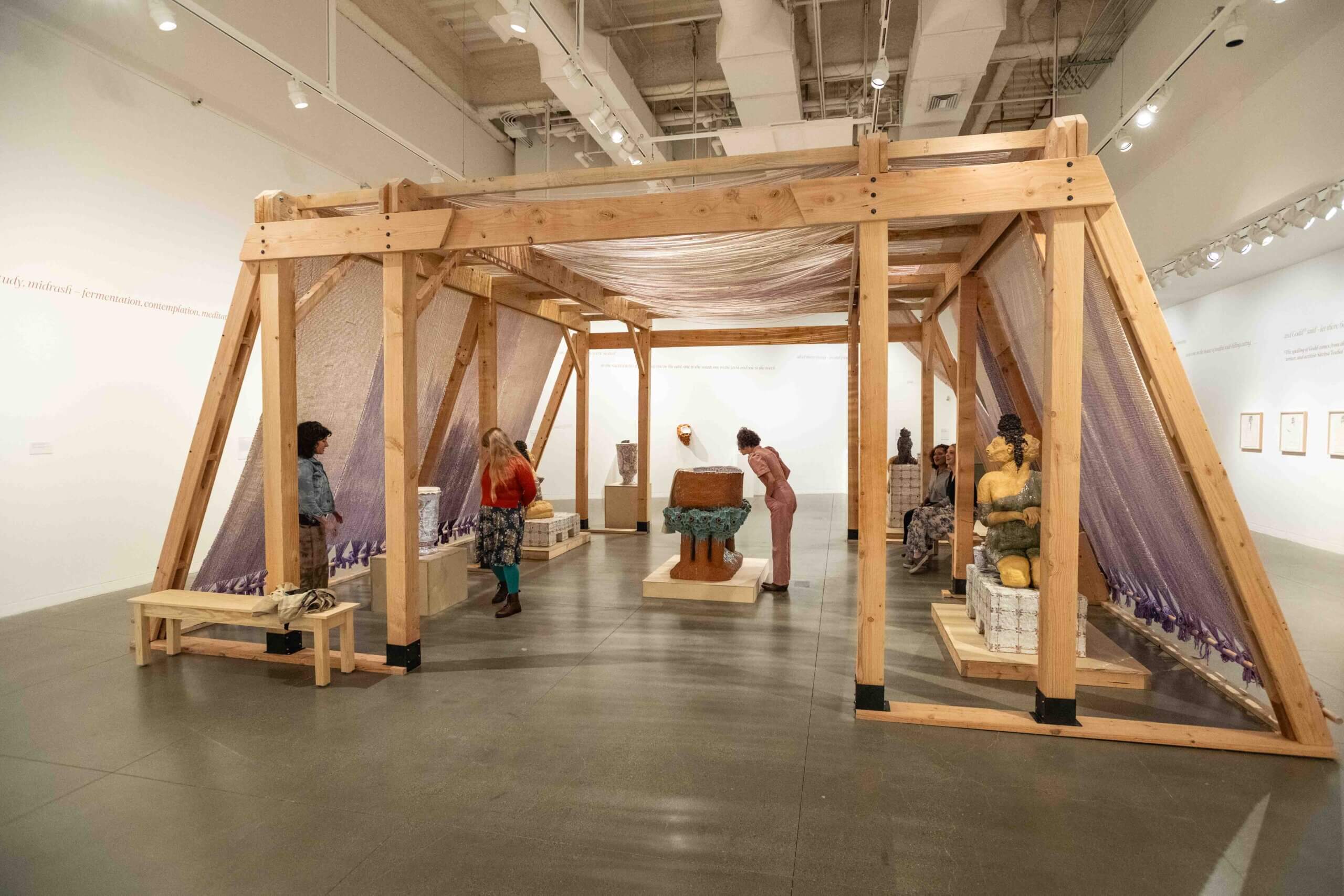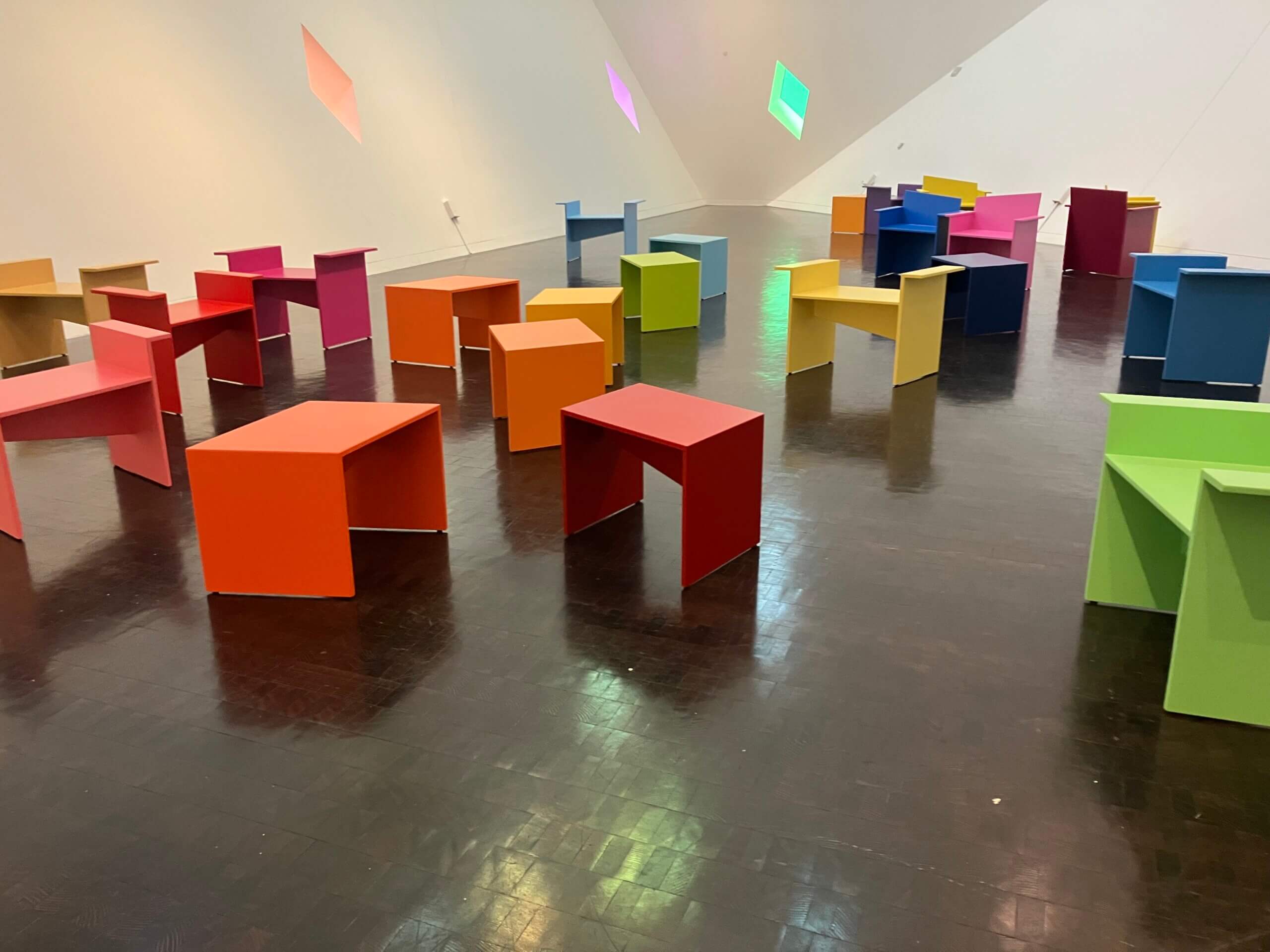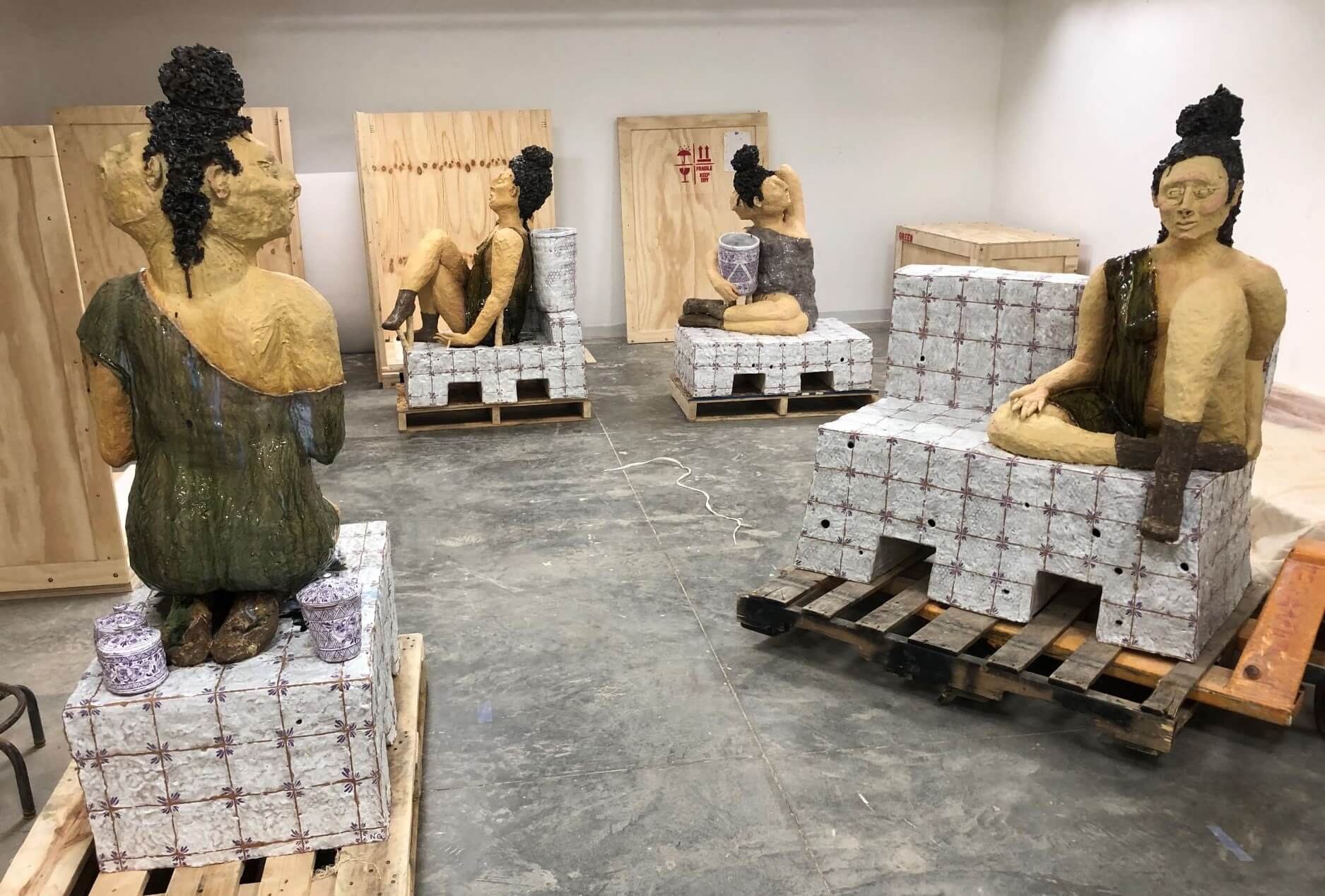Saying ‘adieu’ to San Francisco’s Contemporary Jewish Museum
The museum is closing for at least a year — its final exhibits help explain why

The exterior of the Contemporary Jewish Museum, a former power station redesigned by architect Daniel Libeskind. Photo by Dan Friedman
A girlfriend once made me a music mix that I played until I knew every lyric by heart. It was only when she broke my heart that I, belatedly, realized that every song was about a breakup. Walking into San Francisco’s Contemporary Jewish Museum at the end of 2024 and looking through its five exhibitions gave me a similar, though less tearful, feeling of doom. In hindsight, each show appears to foreshadow an element of the museum’s predicament.
On the outside of the building, three of the exhibits are touted in bright colors. Leah Rosenberg: When One Sees a Rainbow, with its prismatic colored artworks, fleeting as a rainbow, is an exploration of the celebration of redemption in the evanescent. California Jewish Open is a diverse collection of Jewish-identifying artists from the Sunshine State and their connections to their identity or history. And Nicki Green’s Firmament is a nuanced exhibit that foregrounds “destruction” and “regeneration” at the intersection of trans and Jewish culture.
The security guard at the entrance returns my phone, adding “Tickets are over at the counter, entry is free until December 15.” What she means is that the CJM will close on December 15 for what executive director Kerry King says on the museum’s website will be “the period of at least one year.” King, in her turn, means to say that San Francisco’s most famous Jewish museum may well be closing for good. J, The Jewish News of Northern California, will continue to report on the details, but between politics and Covid and the diminishing numbers of people in downtown San Francisco, the CJM’s impact seems to have lessened and the will to plug the increasing financial gap between budget and revenue has likewise diminished.
Moving from the guard to the ticket counter she indicated, visitors see some of the performances that comprise Looted. On multiple screens artists repeatedly create and then erase paintings to indicate the thousands of artworks lost and stolen during the Holocaust. It is a simple and affecting idea. I couldn’t help but be reminded, though, of all the shows that appeared and were taken down at the CJM and all the exhibitions that the museum may never get to stage.
Looted is a reminder too, that without a permanent display to show off the staples of local Jewish museums — local history and the Holocaust — the CJM has felt the need to host exhibitions like Our Struggle: Responding to Mein Kampf (2010) and From Generation to Generation: Inherited Memory and Contemporary Art (2017). Though millions died in the pandemic, it was no Holocaust. However, hosting an exhibition about art lost in a major global upheaval at the same time as the announcement that the museum has not successfully survived the global upheaval of the pandemic, seems to involve an element of self-regard.
Bizarrely wedged into the space between the children’s Zim Zoom room, the bathrooms, and the main exhibition space on the ground floor comes the explicitly self-congratulatory exhibit L’chaim: celebrating our building at 15. As the name suggests, L’chaim is a relatively uncritical look back at Daniel Libeskind’s architectural transformation of an abandoned power station into a Jewish art museum. The crammed wall mostly — though not deliberately — highlights the oddness of the exhibition space in the museum. Edward Rothstein, writing for The New York Times in 2008, called the display spaces “unsettling,” noting that the galleries were “more vertiginous than harmonious.”

Given the chance for retrospection, the museum drifts into nostalgia. L’chaim feels like a bookend to 2008’s triumphant opening, but a flimsy one. It barely touches on what the institution has learned about the building and its ability to engage its audience. The metaphor of a power station, so important in the consideration of the possibilities of the CJM, has faded. The building remains a striking contribution to the San Francisco cityscape, but it runs the risk of becoming just another ruin if it cannot answer how best to generate power from contemporary Jewish art, how to channel it and how it can help to illuminate, connect and warm the hearts of its customers.
One room that Rothstein picked on in his review was the “Yud room.” In Libeskind’s imagination, the building was designed to resemble the word “Chai” with an n-shaped “chet” and the small single upward hook of a “yud.” Rothstein dismissed the “yud” as “so abstract as to be invisible,” and, to an extent, he is right. For the record, I love the building and many of the shows it has hosted. I enjoy the sense of being outside but also inside and alongside a modern ruin on the ground floor. As opposed to the vast warehouse spaces of, say, Dia Beacon, I appreciate the sharp lines that cut across the space, obscuring galleries from each other. I like the feeling of discovery and re-discovery you get from walking around the zigs and zags of the walls. The fact that the entry hall has a kabbalistic intention, however obscurely, makes it all the better.
But, from the start, the Yud room always seemed like a challenge to curators and artists alike. It feels like an important flag when a museum’s physical space is so uninviting that it inspires an audio exhibit, as happened with Are We There Yet? a tribute to thousands of years of Jewish questioning.
Questions literally had to be asked of a show about the Jewish propensity to constantly question and, at the time, I asked them of the installation designers. The Yud room is a small, white, very vertical room with a myriad of skylights. In Leah Rosenberg’s current Rainbow show, the windows are all colored and the room is full of multicolored chairs. One wall features a poster-sized version of the blessing that traditional Jews recite on seeing a rainbow, expressing gratitude to God for saving the world from the flood.
The blessing sits on an extended rainbow of tens of stripes that covers the wall to the floor as if a rainbow was coming to earth on it. The stripes also spread out along a small, rainbow table that juts out to make a short writing space. For each of the stripes there is a matching rainbow slip of paper upon which visitors can write thoughts, thanks, poems, or wishes before putting them into a lucite suggestion box. As Fraidy Aber, Director of Education and Civic Engagement, told me, it is a fun, bright way to use the room. “There is a feeling of wonder and uplift in the space that kids immediately speak about. Sitting on one of 36 colored chairs and watching the rainbow spotlights both fill the grand space and shift around, is awe-inspiring.”

As well as awe and gratitude for redemption, though, Rosenberg invites a celebration of the evanescent. The ephemeral nature of the rainbow makes it especially beautiful, it almost seems a miracle that it ever appeared at all. You never know whether you will see another bright celebration in this way again, whether an actual rainbow, Rosenberg’s show, or — in an apt metonymy — the museum itself.
Walking upstairs from the Yud, I was curious to see two sides of a balcony connected by a version of a tin can telephone. Bonny Nahmias’ grandiloquently named The Orchestra of Space Holders acts as a sort of mezuzah, welcoming people to California Jewish Open. Just as Looted is a reminder that the museum has no permanent Holocaust exhibition, California Jewish Open cannot help but remind us that there is no standing display to explore San Francisco or California Jewishness at the CJM (though there was a successful show about Levi Strauss, whose descendant Daniel Lurie is now the city’s mayor-elect).
From the empty spaces on the wall where anti-Zionist artists refused to allow their chosen works to hang, to Holocaust art, to a sculpted bridal headdress, the work runs the gamut of California Jewish experience.
Some of the works in the exhibition, curated from an open call by Heidi Rabben (Senior Curator) and Elissa Strauss, (artistic director of LABA Bay Area, a Laboratory for Jewish Culture), are more complex and cerebral, while I enjoyed the dreidl-themed gambling video machine, and thought about the intersection of Yiddishkeit and anonymous gambling in a new way. The exhibition provokes neurons to fire all the time and Aber told me that the interactive art in California Jewish Open is meaningful at all ages.
“When we ask students and young kids to think about connections with heritage, they immediately buzz about family holiday meals and favorite special foods,” Aber said, noting that Anna Landa’s A Seat at the Table, a Thanksgiving table set animated with video projected onto it, is always a hit with young people.
“They love how they can join the action right at the table, hear familiar sounds of dishes clanking and join in the projected film and conversation, even touch the silverware and read the fortunes strewn around,” Aber said. “The bonus of hearing a heartbeat when they put their hands over their ears takes it to another level of wow and understanding. They dig it.”
It’s a big exhibition for the CJM and it is peculiarly suitable for an institution that yokes together the two seemingly opposing words “Contemporary” and “Museum” around the perennially complex “Jewish.” Add the implied geographical location of San Francisco or, as in this case, “California,” and you have some substantial complexity. The diversity of the show allows the complexity to breathe but it also made me wonder whether these artists truly had anything in common or whether, at best, they displayed what Ludwig Wittgenstein called “family resemblances.” How Californian Jews relate to art, to Jewishness, and to one another would seem to be a vital question for the CJM, yet it’s one that it has, it seems, arrived too late.
Perhaps because creation itself seems solid, or because the word “firm” opens it phonetically, “firmament” feels like a stable basis for creation. Etymologically though, the word means spread thinly, or “attenuated,” and it is this thinness that inspires Jewish trans artist Nikki Green. Indeed, since the firmament is an almost imperceptibly thin layer between the heavens and earth, it stands not as a barrier but rather as an inflection point. Green is fascinated by this moment of fluidity where one thing becomes something else, and is then fixed in a word or object – like “firmament,” or like the mikveh where Jews move from impure to pure.

Green has worked in explicitly Jewish spaces before, creating new versions of ritual objects like portable clay mikvehs, but this is her first solo museum exhibition. There are many striking things about the exhibition, most notably how not solo it is! Around the walls stretches a new text by “queer elder” Eli Andrew Ramer, and Green prominently features longtime collaborator Ricki Dwyer, who has made another “Firmament” – a building-sized, but loosely woven, covering for the main shelter in the middle of Green’s show Firmament.
Not only does it apparently “take a village” to produce a solo show, but walking into the gallery feels like walking into a village set from an old Star Trek episode. Green has placed objects as if they are part of the communal life of a community: They are recognizable, but have unfamiliar forms. Honeycombed clay receptacles hold salt (for purity and catalysis), half pillars feature pickle tubs on bases, and two-headed angels sit on boxes under Dwyer’s woven canopy. Clay versions of mushrooms and mycelia sprout around the exhibit, giving it an unusual aesthetic. The boxes and shelter are reminiscent of the mishkan or portable ark that was central to Jewish worship millennia ago, but which feels alien to us now. The salt stores and pickle tubs — as well as the text around the walls — are all ways of bringing us to awareness of the state of fermentation in which we live.
We are all in a state of flux; even the calmest village or the most robustly renovated museum is subject to the fluidity of life. What is important, though, is the struggle for liberation and freedom. And, by embracing “resilient fluidity,” perhaps the CJM will survive in whatever new form it finds.
















